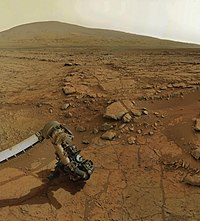중성자별 시스템의 거주가능성
Habitability of neutron star systems
중성자별 리치 주변 행성에 대한 예술가의 비전.
 |
| 이 기사는 다음에 대한 시리즈 중 하나입니다. |
| 우주의 생명체 |
|---|
| 아웃라인 |
| 태양계 행성 거주가능성 |
| 태양계 밖의 생명체 |
중성자별 시스템의 거주 가능성은 중성자별 [1]주위를 도는 행성과 달에서 생명체가 가능한지 여부를 평가하고 조사하는 것을 의미합니다.
중성자별 주위를 도는 생명체가 살 수 있는 행성은 지구 질량의 1배에서 10배 사이에 있어야 합니다.만약 그 행성이 더 가벼웠다면, 그것의 대기는 사라졌을 것입니다.그것의 대기는 또한 모항성에서 방출되는 강렬한 X선 복사를 표면의 열로 전환할 수 있을 정도로 충분히 두꺼워야 합니다.그러면 그것은 [1]생명체에게 적합한 온도를 가질 수 있습니다.
충분히 강한 자기장, 즉 자기권은 강력한 태양풍으로부터 행성을 보호할 것입니다.이것은 그 행성의 대기를 수십억 년 동안 보존할 수 있습니다.그러한 행성은 [1]표면에 액체 상태의 물을 가지고 있을 수 있습니다.
네덜란드의 한 연구팀은 2017년 [2][3]12월에 천문학 & 천체 물리학 저널에 이 주제에 대한 논문을 발표했습니다.
참고 항목
- 적색왜성계의 거주가능성
- K형 주계열성의 거주가능성
- 자연 위성의 거주 가능성
- 로버트 L의 소설 드래곤스 에그와 그 속편 스타퀘이크. 앞으로, 중성자별 자체의 생명체에 관한 것입니다.
레퍼런스
- ^ a b c Suominen, Mikko. "Tutkimus spekuloi pulsaria ympäröivien planeettojen elinkelpoisuudella" [The study speculates on the viability of the planets surrounding the pulsar]. Tähdet ja avaruus; in translation "Stars and space" (in Finnish). Helsinki: Tähtitieteellinen yhdistys Ursa (Ursa Astronomical Association). ISSN 0355-9467. Archived from the original on 2018-07-29. Retrieved 2022-10-07.
According to a Dutch research team, a planet orbiting a neutron star may be surprisingly suitable for life. In other words, liquid water could exist on the planet's surface. The original text: Hollantilaisen tutkimusryhmän mukaan neutronitähteä kiertävä planeetta saattaa hämmästyttävää kyllä sopia elämälle. Toisin sanoen planeetan pinnalla voisi esiintyä nestemäistä vettä.
- ^ Patruno, Alessandro; Kama, Mihkel (2017). "Neutron star planets: Atmospheric processes and irradiation". Astronomy & Astrophysics. EDP Sciences. 608 (A147). doi:10.1051/0004-6361/201731102. ISSN 1432-0746. Archived from the original on 2018-03-29.
p. 9: It is thus possible to speculate that the wind could completely miss the planets orbiting around the pulsar because of a geometric misalignment of the orbital plane with respect to the ion current sheet or negative charge flow.
- ^ "Habitable planets around pulsars theoretically possible". astron.nl. Netherlands Institute for Radio Astronomy (ASTRON). 2017-12-19. Retrieved 2022-10-07.
In the future, the astronomers would love to observe the pulsar in more detail and compare it with other pulsars. The ALMA telescope of the European Southern Observatory would be able to show dust discs around neutron stars.



